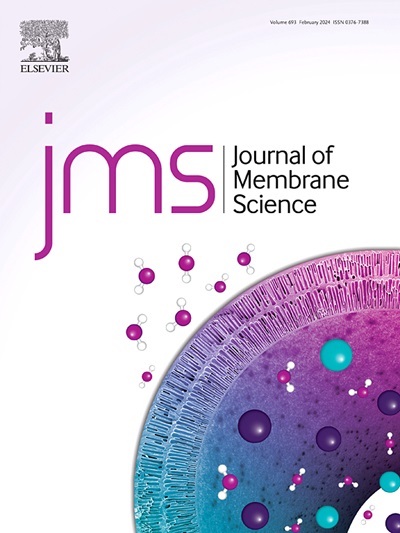cuox包覆钛中空纤维电催化膜高效去除磺胺甲恶唑:制备、性能及降解机理
IF 8.4
1区 工程技术
Q1 ENGINEERING, CHEMICAL
引用次数: 0
摘要
本文采用简单可控的电沉积-热处理方法,在钛中空纤维膜上沉积氧化铜催化剂,制备了新型cux涂层钛中空纤维膜。不同处理温度下得到的CTHM样品表现出不同的催化剂形态、不同的晶体结构和氧空位(OV)浓度,从而导致不同的电化学活性。具体而言,在450℃的热处理温度下,CTHM-450表面形成了菜花状的CuO催化剂,与其他条件下制备的CTHM样品相比,CTHM-450的电化学活性更高。结果表明,CTHM-450具有最佳的电催化过滤处理性能,对磺胺甲恶唑(SMX)和总有机碳(TOC)的去除率分别为96.83%和50.48%。电子顺磁共振(EPR)测试和淬火实验表明,CTHM-450对SMX的高效去除主要是由于电催化氧化过程,该过程以羟基自由基(·OH)、单重态氧(1O2)和硫酸盐自由基(SO4∙-)为主。根据渗透液中检测到的中间产物和密度泛函理论(DFT)的计算结果,分析了SMX在处理过程中可能的降解途径。此外,对检测到的降解产物的毒性进行了分析,证实了使用CTHM的电催化过滤在不提高水溶液毒性的情况下有效地去除SMX。本文章由计算机程序翻译,如有差异,请以英文原文为准。
CuOx-coated titanium hollow fiber electrocatalytic membrane for efficient sulfamethoxazole removal: Preparation, performance and degradation mechanism
In this work, novel CuOx-coated titanium hollow fiber membrane (CTHM) was developed by depositing copper oxide catalyst onto the titanium hollow fiber membrane (THM) through a facile and controllable electrodeposition-thermal treatment. The CTHM samples obtained at different treatment temperatures exhibited varying catalyst morphologies, distinct crystal structures, and oxygen vacancy (OV) concentrations, which resulted in different electrochemical activities. Specifically, at a thermal treatment temperature of 450 °C, a cauliflower-like CuO catalyst was formed on the surface of CTHM-450, exhibiting superior electrochemical activity compared to CTHM samples prepared under other conditions. Consequently, CTHM-450 demonstrated optimal electrocatalytic filtration treatment performance, achieving a removal rate of 96.83% for sulfamethoxazole (SMX) and 50.48% for total organic carbon (TOC). Electron paramagnetic resonance (EPR) tests and quenching experiments indicated that the efficient removal of SMX by CTHM-450 was mainly due to the electrocatalytic oxidation process, which was dominated by hydroxyl radicals (·OH), singlet oxygen (1O2), and sulfate radicals (SO4∙-). The possible degradation pathways of SMX during the treatment were analyzed based on the intermediate products detected in the permeate and computational results obtained from density functional theory (DFT). Moreover, the toxicity of the detected degradation products was analyzed, confirming that the electrocatalytic filtration using CTHM efficiently removes SMX without elevating the toxicity of the aqueous solution.
求助全文
通过发布文献求助,成功后即可免费获取论文全文。
去求助
来源期刊

Journal of Membrane Science
工程技术-高分子科学
CiteScore
17.10
自引率
17.90%
发文量
1031
审稿时长
2.5 months
期刊介绍:
The Journal of Membrane Science is a publication that focuses on membrane systems and is aimed at academic and industrial chemists, chemical engineers, materials scientists, and membranologists. It publishes original research and reviews on various aspects of membrane transport, membrane formation/structure, fouling, module/process design, and processes/applications. The journal primarily focuses on the structure, function, and performance of non-biological membranes but also includes papers that relate to biological membranes. The Journal of Membrane Science publishes Full Text Papers, State-of-the-Art Reviews, Letters to the Editor, and Perspectives.
 求助内容:
求助内容: 应助结果提醒方式:
应助结果提醒方式:


